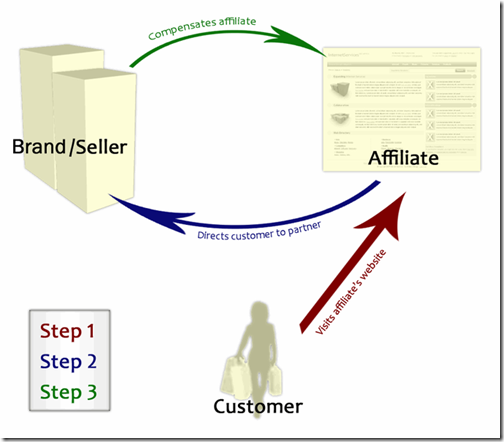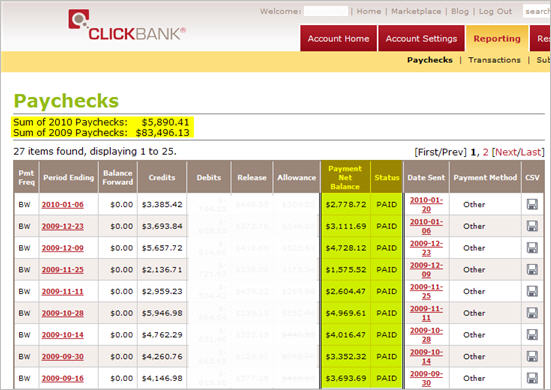In our online marketing preview article, we briefly explain what affiliate marketing was but did not go into exact details. For Part 1 of our How To Make Money Online series, we will be teaching you more specifically on the process of affiliate marketing from the backend to the end user. We will also explain the different variables that exists which dictate how much money you can possibly earn per product. Let’s get started!
As stated previously, affiliate marketing is a form of commission based revenue. You simply get paid to promote someone elses product / brand. A more detailed explanation can be seen in the image below.

This image that we grabbed off Wikipedia shows the overall process flow of affiliate marketing. I included a Step 0 since I feel they left out an important step. Key terms are defined below…
How Affiliate Marketing Works
Step 0 – You (the affiliate), partner up with a brand/seller usually through an affiliate network.
Step 1 – You own a website and send targeted traffic to your website through any means whether its paid or free.
Step 2 – On your website you have content about something the customer wants. They decide to click your affiliate link and are forwarded to the brand/seller/merchant website.
Step 3 – If the customer makes a purchase within the duration of the cookie lifespan then you get the commission.
Step 4 – Profit!
Targeted Traffic + Matching Demographic = Profit
Key Terms To Know
Affiliate Link – A special link given to you by either an affiliate network / merchant that specifically tracks your activity. For example: How many clicks, how many sales, how many impressions, etc…
Affiliate Network – A middleman between the brand/merchant and affiliate (you). They are simply a broker between the two entities. The affiliate networks handle everything from providing you the affiliate links and tracking your activity to writing you the pay checks. In most cases you must be approved to join an affiliate network. We will discuss which networks to join in part 3.
Cookie – A cookie is piece of data stored on your computer. Cookies are usually used for authentication (forums, email) or simply storing preferences. With affiliate marketing, whenever you click on an affiliate link, a cookie for that specific merchant is stored on your computer. Cookie duration varies between merchants. For example: If “Mike’s Pets Store” has a cookie duration of 14 days, that means from the moment a customer clicks on your affiliate link, they have up to 14 days to make a purchase. This means that on October 1 they could have clicked your affiliate link to the merchant and not bought anything. But if they revisited “Mike’s Pets Store” on October 9 and made a purchase, you would still get commission for the sale.
Types of Commissions
These are the most common types of commissions you can earn. There are more but these types are what you will find 99% of the time because of the simplicity and ease. There is no best type as different merchant offer different options.
CPA – Short for “Cost Per Action.” In this form of commission, you are compensated when the end user (customer) performs an action on the merchant website. This can be anything from signing up with a new account on a dating website to submitting their zipcode to get a free insurance quote.
CPS – Short for “Cost Per Sale.” A simple form of commission where you get compensated a certain percentage for each sale made on the merchant website. You’ll see this a lot with actual physical products and big brands such as a clothing brands.
CPL – Short for “Cost Per Lead.” Very similar to CPA, except you get paid for every lead you send to a merchant. Affiliate marketing is very much so a lead generation business. You will see a lot of these with merchants that require your email address.
Miscellaneous Terms To Know
Conversion Rate –The ratio of how many actions are performed from the total clicks of your affiliate link.
EPC – Short for “Earnings Per Click.” A good metric to understand how much each click is earning you. The formula is total commissions divided by total clicks.
Pay Out – How much the merchant is willing to pay you. Can range anywhere from $0.50 to $1000+.
A Scenario To Sum It Up
John, owner of www.carmufflers.com, reviews a wide variety of automotive exhaust systems from all brands. John does NOT stock any inventory and does NOT dropship. His website simply has a compilation of different exhausts for different makes with soundclips and individual reviews he’s gathered from forums. One of the major brands is Borla Exhaust which he is an affiliate of. Borla pays its affiliates 9% for every sale made with a cookie duration of 7 days.
Alex, a Honda Civic enthusiast, is looking for the best exhaust for the money. He stumbles on John’s carmufflers.com after doing some research on Google. After much debate Alex decides to go with a Borla catback exhaust system for his Honda Civic. After spending enough time on John’s website, Alex clicks John’s affiliate link to the Borla Exhaust Honda Civic page. Right there is when the cookie is stored on Alex’s computer. John (the affiliate) will ONLY get commission if Alex decides to make a purchase within the 7 days. Luckily for John, Alex decides to buy a $239 exhaust system. This means that John would have just made $21.51 for this one sale.
More To Come…
In our next article, we show you how many people are capitalizing on unemployment and tricking consumers into paying for work from home scams that simply do not work and steal your money. You don’t want to miss this!
